Just when you think you understand a bird, a group of birds, or a species, a new wrinkle adds another element of interest to your line of thinking. And that’s exactly what happened at the Pelican Lakes this year. Just when we thought we had a pretty good grasp on the nesting chronology of the loons that nest and raise their hatchlings on these closely associated lakes, we were surprised beyond our collective imagination.
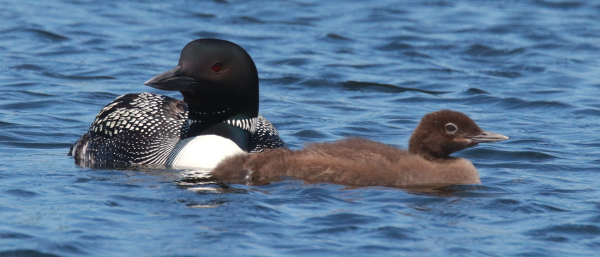
During the previous 3 years, my friend Andy and I observed and photographed Common Loons on Little Pelican Lake, where Andy resides. I kept track of the apparent hatch dates each year and it was quite clear that young loons on Little Pelican Lake hatched during the last week of June each year. And although we boated along the connecting river to the much larger Pelican Lake other years, we never encountered a family group of Common Loons in the eastern third of that lake – we saw adults, single and in pairs, but never young loons.
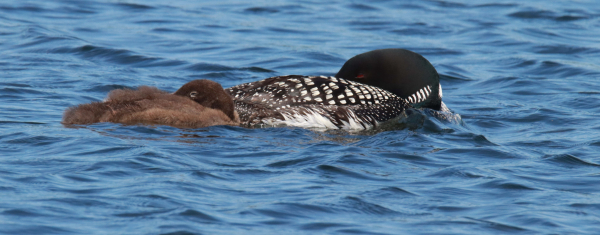
However, this year during an earlier than usual first visit to see Andy on June 5th, we couldn’t resist checking for territorial loons on Litte Pelican Lake. After circling Little Pelican and photographing a lone Common Loon, which we imagined had a mate incubating eggs on a nest nearby, we progressed along the small connecting river to Pelican Lake. There, near the eastern shoreline we were astonished to find a pair of loons with 2 newly hatched downy young – on June 5th!
The morning was overcast and although we managed some nice photographs of the loon family featuring the newly hatched twins, I set my sights on returning the following week when we would have the benefit of ample sunlight to photograph and try to learn more about the early nesting loons at Pelican Lake. Was this a freak early-nesting effort by this loon pair? At the time, it seemed that was the case considering past experiences on Little Pelican Lake.
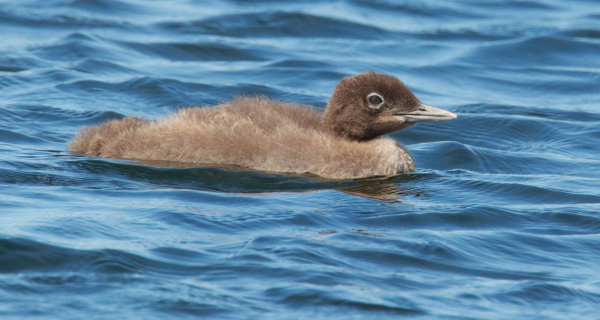
Returning 6 days later, on June 11th, my friend Andy and I were especially surprised to find 2 more pairs of loons with newly hatched downy twins – but all on Pelican Lake. On Little Pelican we observed a pair of Common Loons actively diving and covering a wide swath of the northwest side of the lake – hmm.
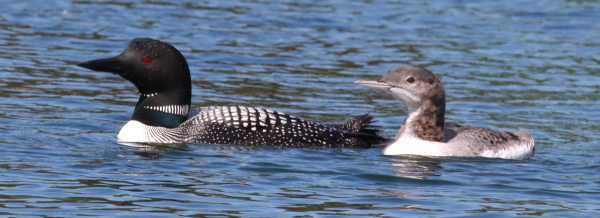
Fast forward to last Wednesday’s loon cruise (July 9th): We immediately saw a pair of loons with a downy hatchling about 2 weeks after hatching from Andy’s dock on Little Pelican Lake, and moments later we enjoyed an afternoon photo session with them. So laid back was this loon family that as the male preened, the female and hatchling dozed in the afternoon sun. The timing of this young loon’s hatching was exactly when we expected Common Loons to hatch on Little Pelican. But now the question was: Why were pairs of Common Loons laying eggs 3 weeks earlier on neighboring Pelican Lake?
While that will be a tough new question to answer, we left the loon family and headed toward the much bigger Pelican Lake, and even before we made the first turn out of the river channel into the east side of the big lake, I spied a pair of loons with 2 large hatchlings. Judging by the positioning of these loons, it seemed that this might be the first family group we encountered on June 5th.

The big surprise was how well-developed the 5-week-old hatchlings were. They already replaced their brown-colored down with most of their first-year plumage, but they still had vestiges of down on their neck and head in places, soon to be molted too. These feathered hatchlings were about 2/3rds the size of the adults, and it was amazing to see the difference in size and plumage development between the 2 loon families in the 2 adjoining lakes. But why was there such a considerable difference in nesting and hatching dates at 2 lakes that are only a few hundred yards apart?
In this case, it was bird photography that made me initiate planning for this photo cruise, but it turned out that our observations helped to answer an interesting birding question that came up before: “Why did loons nest 3 weeks earlier this year?” We learned that Common Loons didn’t nest earlier on Little Pelican Lake where all our previous loon families have nested. But this loon cruise added a new question to press forward with: “Why did the loons on adjoining lakes nest 3 weeks apart this year?” That question will be harder to answer, with the search for an answer probably stretching into future years of study and photography at the Pelican Lakes, which is an especially good thing.
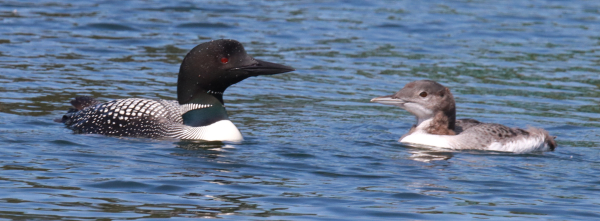
Another question that arises is: Why haven’t we seen evidence of Common Loons nesting in the eastern third of Pelican Lake before? We have done expansive searches, but never observed hatchlings there until this year when we found 3 pairs with downy twins. We’ll keep those queries in mind, but in the meantime it is especially enjoyable to be in the company of loons, to watch their activities, interactions, and growth, and to take photographs of these special birds throughout the Minnesota loon season.
This particular Bird Photography feature is a bit less about the photo techniques than it is about the kinds of things that may be revealed when you make repeated photo trips to a given location. It also shows how birding can open a new way of appreciating the behavior of birds on a larger scale – even on a scale that spans years of observations and photo encounters. Enjoy any water or shore time you can muster this summer with birding a part of the activity mix, and consider searching out a Common Loon sighting of your own, especially if you live near a lake within the range of loons.
Article and Photographs by Paul Konrad
Share your bird photos and birding experiences at editorstbw2@gmail.com